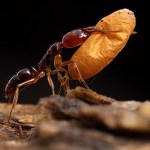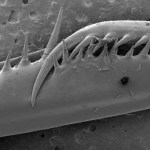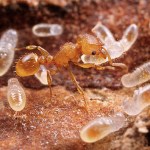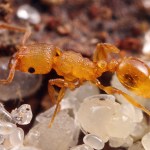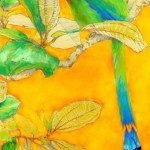
Mystery #1
I admit, I like to pick on iStockphoto, the pioneering company behind the high volume/low cost microstock model of media licensing.
There's nothing wrong with microstock. After all, the thriving web-based market for cheap images is a ripe opportunity. But buyers get what they pay for, and they should be aware that a photographer who nets forty cents an image is unlikely to fact-check with the same level of rigor as one paid $400 an image. So the microstocks are entertainingly peppered with error.
Tonight's challenge: put a name on each of these ten taxonomic disasters from the…
Playwright Tom Stoppard retells Shakespeare's Hamlet as an absurd comedy from the perspective of two minor characters. The brilliant Gary Oldman and Tim Roth star in Stoppard's own film adaptation (1990). Here's an excerpt:
Aphaenogaster woodland ants disperse a bloodroot seed. This image materialized in my head a couple months before I actually set it up.
My photographs fall into two categories: incidental shots I happen upon by chance, and premeditated images mapped out in advance. There's not much to say about the first type. I wander about in the woods as another camera-toting tourist, and sometimes I get lucky with an interesting subject. A naturalist's eye and a basic ability to operate photographic equipment suffice to produce usable photos.
As my photographic career progresses, though, more of my…
Time for a little rant. I've been assembling the syllabus for a summer beekeeping course here at the University of Illinois- the first time we've offered beekeeping as a regular class in over 30 years- and I've run into an annoying snag: the lack of a suitable textbook.
There's no shortage of books about bees. From The Beekeeper's Handbook to Beekeeping for Dummies, hundreds of volumes have been penned for the starting hobbyist. Others are works of literary art, like Sue Hubbell's musings in A Book of Bees. The internet hosts online forums and thousands of how-to beekeeping videos. Many of…
Anochetus paripungens trap-jaw ant carrying a cocoon, Australia
photo details:
Canon EOS 50D camera
Canon MP-E 65mm 1-5x macro lens
ISO 100, f/13, 1/250sec
twin flash heads placed in front and behind the subject.
You folks are quick. Not two minutes after I posted yesterday's mystery bug, commentator FormicidaeFantasy provided the correct answer: it is the forelimb of a praying mantis. Specifically, a nymph of the Carolina mantis Stagmomantis carolina.
So, eight highly valuable Myrmecos Points go to FormicidaeFantasy. A number of you chimed in with additional relevant information. A point each for Chris Grinter, Christopher Taylor, James Trager, Tim Eisele, and Peter Coffey.
You've seen the ISO button on your camera. What does it do, and why does it matter?
ISO- an abbreviation for International Organization for Standardization- refers to a standard measure of the sensitivity of film or digital sensors to incoming light. The higher the ISO rating, the more sensitive the sensor and the less light required to form an image. Wikipedia carries a nice summary of the technical details.
Most digital cameras support a range of ISO ratings from 100 to 3200 or even higher. These ratings are calibrated so that a doubling in number indicates a doubling of sensitivity. ISO…
This looks like it could be painful. What is it?
Five points to the first person to name the organism, and five for the structure.
The cumulative points winner for the month of May will win either 1) any 8x10 print from my insect photo gallery, or 2) a guest blog post on the (safe-for-work) topic of their choosing.
[SEM image by the lovely and talented Elle Camino]
A clip from the documentary "Ants: Nature's Secret Power":
The Boneyard Bombshells (red) take on The 'Paign (blue) in Champaign-Urbana's first ever roller derby bout
How many rocket scientists does it take to set up a roller derby bout?
Apparently, the answer is two. That's how many were on hand Friday night to help lay the track for Champaign-Urbana roller derby's sold-out exhibition bout. In a university town there's a lot of spare expertise floating around. I'm pretty sure we had the most precise track ever measured out in the history of the sport, and the league is only four months old.
Mrs. Myrmecos (a.k.a. Elle Camino) skates for the…
Asphinctopone pilosa Hawkes 2010
The discovery of new insect species continues apace. Today, the online journal Zootaxa presents this pretty little ponerine from Tanzania, described by Peter Hawkes.
Asphinctopone is a rather poorly-known genus previously collected only in the tropical forests of West Africa. Asphinctopone pilosa is larger than the other described species and the first record from East Africa, extending the range of the lineage thousands of kilometers to the east.
source: Hawkes, P.G. 2010. A new species of Asphinctopone (Hymenoptera: Formicidae: Ponerinae) from Tanzania.…
Biologist Henry Hespenheide sends along this shot of several ant-mimicking beetles and their Cephalotes model:
What I take from this image is just how important the appearance of a narrow waist must be to successfully pulling off the illusion. These mimics differ considerably in body proportions, but they have all managed to paint a fake waist on their elytra.
This shot was taken in the natural ambience of our living room with the soft light of a rainy dusk filtering through the windows. I coaxed Mingus the Cat to the top of the bookshelf with some treats and waited for him to check out the boquet.
Owing to the lack of light I used a fast lens (Canon's 35mm f2.0 prime) open to f2.0 at ISO 1600.
Who was that dashing ant of mystery and intrigue?
Tetramorium simillimum is a small myrmicine that has tramped around the globe with human commerce, quietly inserting itself into native ecosystems. Like most insect species, little is known about its behavior or its interactions with other species.
JasonC gets a clean sweep: ten points for correctly guessing the genus and species.
We haven't done an ant mystery for ages. So here you go:
Although I photographed this little ant in Florida, it could just as easily have been in a number of tropical places.
Five points each for the first person to pick the genus and the species.
The cumulative points winner for the month of May will win either 1) any 8x10 print from my insect photo galleries, or 2) a guest blog post on the (safe-for-work) topic of their choosing.
Natural disasters are things we see in the news. A flood in Bangladesh, earthquakes in China, wildfires in California- all reported in somber tones before the commercial break, often presented with some generic disaster clip of people sorting through rubble. These events have a defining feature: they happen to other people. Not to us, or to anyone we know.
Debby and Mike Kaspari in the box where they weathered the storm
An exception to this principle of natural disasters touched down in Oklahoma last week. The tornados that killed several people nearly took two of our own: artist/blogger…
Bits and pieces of an ongoing project to sequence the genome of the leafcutter ant Atta cephalotes have started going up on Genbank- Have a look!
Of course, these are just raw strings of nucleotides that haven't yet been annotated or analyzed in any meaningful way. The real science won't begin until researchers begin testing hypotheses against the data. But the raw material is there, and this is the first sequence from the ant genome projects to see the light of day. Exciting stuff!
Heterospilus, undescribed species, Costa Rica
My more astute readers may have noticed that Myrmecos Blog has been uncharacteristically quiet this week. I do apologize, but I have a regular research job aside from blogging that periodically requires attention.
I've been assembling genetic and morphological data from 100 or so wasps in the hyperdiverse genus Heterospilus. These are small insects, typically under a centimenter in length, that attack stem-boring grubs like beetle and moth larvae. This week I am patching up the holes in the molecular data matrix, and this requires bench time…
What was the mystery?
It's a unique-headed bug in the enigmatic family Enicocephalidae. These soil-dwelling insects are predators of other arthropods. They are of phylogenetic interest as a potential sister lineage to the remaining Heteroptera, the true bugs.
Enicocephalids aren't terribly common- I can count on one hand the times I've seen them in the field- and I was most surprised to find one scurrying about under a stone in my small urban front yard.
Five points to James Trager, who first picked the order. And five more to Kojun, who got the family.

